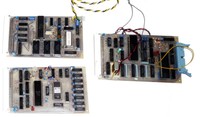SC84
| Home > Browse Our Collection > Computers > Custom-Built Computers > SC84 |
|
In 1979, the British magazine Wireless World published the technical details for a "Scientific Computer". Shortly afterward the British firm Powertran Computers of Andover in Hampshire UK used this design for their kit computer, the PSI Comp 80. During the mid-1980s the designer, John Adams, published a new version of the Scientific Computer - the SC84 (Scientific Computer of 1984). It was based upon a backplane and plug-in cards and modules and was initially based around the Z80 processor. Later versions featured a Hitachi HD64180 processor, up to 512 kbytes of RAM, and a high resolution colour graphics system. Add-ons were developed for the system, including memory expansions, floppy and hard disk interfaces, various software packages and a disk operating system, SCIDOS, which was CP/M-compatible. Version 3 of SCIDOS ran only on the HD64180 processor and took advantage of the built-in memory management unit (MMU) to page out the BIOS and operating system; this allowed more free memory for user programs. It also included structured (pathed) disk folders, an improvement over the CP/M-style single directory that the original Z80 version had. Our SC84 is built into a Superbrain case and, together with literature and documents, was kindly donated by Mike Baron. The images to the right show (from top to bottom): SC84 Video card, SC84 Z80 CPU card, and SC84 Floppy Disk/GPIO/Serial interface card SC84 specification:
Manufacturer: John Adams Comment on This Page Magazines RELATED to SC84 in our LibraryThis exhibit has a reference ID of CH22148. Please quote this reference ID in any communication with the Centre for Computing History. |
|














